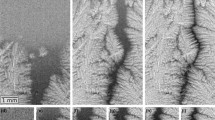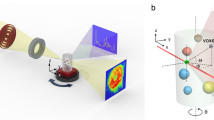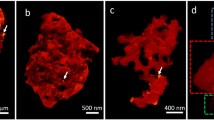Abstract
Scanning electron microscopy (SEM), combined with energy-dispersive spectroscopy (EDS), is an extensively used technique for in-depth microstructural analysis. Here, we present the EDS-Phase Segmentation (EDS-PhaSe) tool that enables phase segmentation and phase analysis using the EDS elemental map images. It converts the EDS map images into estimated composition maps for calculating markers of selective elemental redistribution in the scanned area and creates a phase-segmented micrograph while providing approximate fraction and composition of each identified phase. EDS-PhaSe offers two unique advantages. Firstly, it enables the direct processing of EDS elemental map images without requiring any raw or proprietary data/software, thereby allowing the analysis of EDS results available in the published literature as images. Secondly, it enables segmentation and analysis of phases even when the phase contrast is missing in backscattered micrographs, assisting in correlating the XRD and SEM-EDS data as shown in this work for a AlCoCrFeNi high-entropy alloy.






Similar content being viewed by others
Code Availability
The code for EDS-PhaSe, wrapped in interactive Jupyter notebooks, is available at ‘IDEAsLab-Computational-Microstructure’ organization page on GitHub (https://github.com/IDEAsLab-Computational-Microstructure/EDS-PhaSe). Any enquiries related to the code may be directed to DB and PKR.
References
J.I. Goldstein, D.E. Newbury, J.R. Michael, N.W.M. Ritchie, J.H.J. Scott, D.C. Joy (2018) Scanning Electron Microscopy and X-Ray Microanalysis. Springer, New York, NY, 2018. https://doi.org/10.1007/978-1-4939-6676-9.
B. Münch, L. Martin, A. Leemann, Segmentation of elemental EDS maps by means of multiple clustering combined with phase identification. J. Microsc. 260, 411–426 (2015). https://doi.org/10.1111/jmi.12309
R. Juránek, J. Výravský, M. Kolář, D. Motl, P. Zemčík, Graph-based deep learning segmentation of EDS spectral images for automated mineral phase analysis. Comput. Geosci. 165, 105109 (2022). https://doi.org/10.1016/j.cageo.2022.105109
F. Georget, W. Wilson, K.L. Scrivener, edxia: Microstructure characterisation from quantified SEM-EDS hypermaps. Cem. Concr. Res. 141, 106327 (2021). https://doi.org/10.1016/j.cemconres.2020.106327
J.B. Byrnes, A.A. Gazder, S.A. Yamini, Assessing phase discrimination via the segmentation of an elemental energy dispersive X-ray spectroscopy map: a case study of Bi2Te3 and Bi2Te2S. RSC Adv. 8, 7457–7464 (2018). https://doi.org/10.1039/C7RA08594J
P.T. Durdziński, C.F. Dunant, M.B. Haha, K.L. Scrivener, A new quantification method based on SEM-EDS to assess fly ash composition and study the reaction of its individual components in hydrating cement paste. Cem. Concr. Res. 73, 111–122 (2015). https://doi.org/10.1016/j.cemconres.2015.02.008
V. Shivam, Y. Shadangi, J. Basu, N.K. Mukhopadhyay, Evolution of phases, hardness and magnetic properties of AlCoCrFeNi high entropy alloy processed by mechanical alloying. J. Alloys Compd. 832, 154826 (2020). https://doi.org/10.1016/j.jallcom.2020.154826
V. Shivam, D. Beniwal, Y. Shadangi, P. Singh, V.S. Hariharan, G. Phanikumar, D.D. Johnson, P.K. Ray, N.K. Mukhopadhyay, Effect of Zn addition on phase selection in AlCrFeCoNiZn high-entropy alloy. SSRN Electron. J. (Preprint). (2022). https://doi.org/10.2139/ssrn.4263461
J.M. Cowley, Short-range order and long-range order parameters. Phys. Rev. 138, A1384–A1389 (1965). https://doi.org/10.1103/PhysRev.138.A1384
Y. Rao, W.A. Curtin, Analytical models of short-range order in FCC and BCC alloys. Acta Mater. 226, 117621 (2022). https://doi.org/10.1016/j.actamat.2022.117621
P. Singh, A.V. Smirnov, D.D. Johnson, Atomic short-range order and incipient long-range order in high-entropy alloys. Phys. Rev. B. 91, 224204 (2015). https://doi.org/10.1103/PhysRevB.91.224204
D. Porter, K. Easterling, Phase Transformations in Metals and Alloys (Revised Reprint). CRC Press. (2009). https://doi.org/10.1201/9781439883570
D. Beniwal, P.K. Ray, Learning phase selection and assemblages in high-entropy alloys through a stochastic ensemble-averaging model. Comput. Mater. Sci. 197, 110647 (2021). https://doi.org/10.1016/j.commatsci.2021.110647
M. Wu, S. Wang, H. Huang, D. Shu, B. Sun, CALPHAD aided eutectic high-entropy alloy design. Mater. Lett. 262, 127175 (2020). https://doi.org/10.1016/j.matlet.2019.127175
D. Beniwal, P.K. Ray, FCC vs. BCC phase selection in high-entropy alloys via simplified and interpretable reduction of machine learning models. Materialia. 26, 101632 (2022). https://doi.org/10.1016/j.mtla.2022.101632
C. Liu, A. Garner, H. Zhao, P.B. Prangnell, B. Gault, D. Raabe, P. Shanthraj, CALPHAD-informed phase-field modeling of grain boundary microchemistry and precipitation in Al–Zn–Mg–Cu alloys. Acta Mater. 214, 116966 (2021). https://doi.org/10.1016/j.actamat.2021.116966
D. Beniwal, Jhalak, P.K. Ray, Data-Driven Phase Selection, Property Prediction and Force-Field Development in Multi-Principal Element Alloys, in: A. Verma, S. Mavinkere Rangappa, S. Ogata, S. Siengchin (Eds.), Forcefields for Atomistic-Scale Simulations: Materials and Applications, Springer Nature, Singapore,: pp. 315–347. https://doi.org/10.1007/978-981-19-3092-8_16.
W. Wang, H.-L. Chen, H. Larsson, H. Mao, Thermodynamic constitution of the Al–Cu–Ni system modeled by CALPHAD and ab initio methodology for designing high entropy alloys. Calphad. 65, 346–369 (2019). https://doi.org/10.1016/j.calphad.2019.03.011
Q. Han, Z. Lu, S. Zhao, Y. Su, H. Cui, Data-driven based phase constitution prediction in high entropy alloys. Comput. Mater. Sci. 215, 111774 (2022). https://doi.org/10.1016/j.commatsci.2022.111774
D. Beniwal, P.K. Ray, CoSMoR: decoding decision-making process along continuous composition pathways in machine learning models trained for material properties. Phys. Rev. Mater. 7, 043802 (2023). https://doi.org/10.1103/PhysRevMaterials.7.043802
P. Singh, A.V. Smirnov, A. Alam, D.D. Johnson, First-principles prediction of incipient order in arbitrary high-entropy alloys: exemplified in Ti0.25CrFeNiAlx. Acta Mater. 189, 248–254 (2020). https://doi.org/10.1016/j.actamat.2020.02.063
P. Singh, A.V. Smirnov, D.D. Johnson, Ta-Nb-Mo-W refractory high-entropy alloys: anomalous ordering behavior and its intriguing electronic origin. Phys. Rev. Mater. 2, 055004 (2018). https://doi.org/10.1103/PhysRevMaterials.2.055004
D. Beniwal, P. Singh, S. Gupta, M.J. Kramer, D.D. Johnson, P.K. Ray, Distilling physical origins of hardness in multi-principal element alloys directly from ensemble neural network models. Npj Comput. Mater. 8, 1–11 (2022). https://doi.org/10.1038/s41524-022-00842-3
L. Gránásy, G.I. Tóth, J.A. Warren, F. Podmaniczky, G. Tegze, L. Rátkai, T. Pusztai, Phase-field modeling of crystal nucleation in undercooled liquids—A review. Prog. Mater. Sci. 106, 100569 (2019). https://doi.org/10.1016/j.pmatsci.2019.05.002
X.J. Zuo, Y. Coutinho, S. Chatterjee, N. Moelans, Phase field simulations of FCC to BCC phase transformation in (Al)CrFeNi medium entropy alloys. Mater. Theory. 6, 12 (2022). https://doi.org/10.1186/s41313-021-00034-4
Acknowledgements
DB acknowledges the financial support from Prime Minister’s Research Fellows (PMRF) scheme run by Ministry of Education, Government of India. PKR acknowledges the support from Science and Engineering Research Board, Department of Science and Technology grant (# CRG/2021/006974). Analysis of the Haynes-282 (OP and MJK) was supported by the US Department of Energy (DOE), Office of Fossil Energy, Crosscutting Research Program. Research was performed at Iowa State University and Ames Laboratory, which is operated by ISU for the US DOE under contract DE-AC02-07CH11358. We acknowledge support from Haynes International (Dr. Vinay Deodeshmukh), who provided the Haynes-282 alloy.
Author information
Authors and Affiliations
Corresponding author
Additional information
Publisher's Note
Springer Nature remains neutral with regard to jurisdictional claims in published maps and institutional affiliations.
This invited article is part of a special topical focus in the journal Metallography, Microstructure, and Analysis on Microstructure Modeling.
Rights and permissions
Springer Nature or its licensor (e.g. a society or other partner) holds exclusive rights to this article under a publishing agreement with the author(s) or other rightsholder(s); author self-archiving of the accepted manuscript version of this article is solely governed by the terms of such publishing agreement and applicable law.
About this article
Cite this article
Beniwal, D., Shivam, V., Palasyuk, O. et al. EDS-PhaSe: Phase Segmentation and Analysis from EDS Elemental Map Images Using Markers of Elemental Segregation. Metallogr. Microstruct. Anal. 12, 924–933 (2023). https://doi.org/10.1007/s13632-023-01020-7
Received:
Revised:
Accepted:
Published:
Issue Date:
DOI: https://doi.org/10.1007/s13632-023-01020-7




